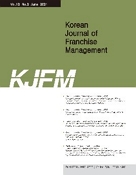 E-ISSN : 2508-4593
E-ISSN : 2508-4593
Vol.6 No.1
Abstract
Home Meal Replacement (HMR) products are ready-to-eat or pre-cooked food products that are consumed at daily home. HMR market has grown rapidly due to societal changes: increases in female social activities, silver population, and one-person households. Consumption channels of HMR can be classified into take-out, delivery, and retail. In Korean HMR market, retail sector is largely growing, but companies are focusing their business on the home delivery sector. Moreover, franchise companies are expanding their areal coverage in the HMR market based on their multi-unit strategy. However, more research on the HMR market is needed as existing studies are limited in conceptualization, classification, and processed food from malls or home-shopping channels. Therefore, we conducted the efficiency analysis on Gukseonsaeng, one of franchises that applied the take-out channel, using DEA method. According to the research on 29 franchisees of Gukseonsaeng, 77.9% of input appeared inefficient for technical efficiency, while 53.3% of input appeared inefficient for scale efficiency. Thus, we found that franchises of Gukseonsaeng are structured in increasing returns to scale (IRS), so enhancing efficiency by expanding scales need to be implemented.
Abstract
The purpose of the study is to review the real situations of the income-gap between urban and rural areas which is focused on as one of the biggest issues revealed in the process of Chinese economic development and to find out which factors will alleviate or deteriorate such income-gap, also to find out such factors will effect differently on the regional characteristics. To analyze it, six factors such as industrialization-ratio, urbanization-ratio, tertiary industry-ratio, the level of both governmental educational support and agricultural support, and Chinese dual-economic structure are considered as explanatory variables, and OLS regression analysis was implemented to the factor data for the period of 1986-2007 about Chinese 31 districts(castles and cities). The results of the analysis show that both industrialization factors and urbanization factors affect significantly to alleviate income-gap between urban and rural areas, and as predicted, they also shows that dual-economic structure between urban and rural areas is the most biggest factors to enlarge the above mentioned income-gap. However, in accordance to the different level of economic development in eastern, central, and western districts the study shows that such factors will affect them differently respectively. The contents are as follows; In eastern district governmental educational support factor will affect the most great influence to alleviate the income-gap, in central district industrialization factor will affect the most great influence to alleviate the gap, and western district governmental agricultural support factor will affect the most great influence to alleviate the gap. Therefore, in solving the issue of income-gap between urban and rural areas in China we recommend that it is necessary for more differential policy in considering regional characteristics than unilateral policy to Chinese whole areas.
Abstract
As franchise industry has grown, the role of a supervisor who is a contact point between franchisor and franchisees has become more vital to success of the business. This research, focusing on his/her specific role, explores communication type, leadership type, and followership type of the supervisor in relations with the organization, franchisor, and franchisees, respectively. Furthermore, we compared performance of franchises by the three types above through the franchise contract management leverage (FCML) which reflects business performance both qualitatively and quantitatively. According to the analysis on supervisors of a franchise business, 'Ganiyeok', the majority of supervisors' communication type were either supportive style or directive style. For the leadership type, team-type and impoverished-type leaders were the majority, while effective or passive followership appeared highest in followership type. In addition, supportive supervisors in communication style, team-type supervisors in leadership style, and effective supervisors in followership had highest FCML, while reflective and directive styles, impoverished style, and passive style had lowest FCML. Primary goal of a franchise business is stable profit generation. This study not only examined what characteristics supervisors need and which style is insufficient, but also proposed tailored solutions for each style. Thus, we confirmed that debates on franchise can be approached in perspective of both communication and business, and we further suggest diverse approaches on future franchise business.
Abstract
This study aims to provide managerial implications considering strategic priorities for maintaining existing customers and attracting new customers in extremely competitive coffee franchise market. In particular, this study is differentiated from other previous studies as it attempted to examine both direct and indirect impact relations among self-congruity, functional congruity, perceived value(utilitarian/hedonic value), and attitude. Also, this study shows the relative impact of utilitarian value and hedonic value on attitude. The results show that self-congruity has positive effects on functional congruity and value (hedonic and utilitarian value), while functional congruity has positive effects on utilitarian value, hedonic value, and attitude. Moreover, self-congruity has indirect effects on attitude through functional congruity and value. The findings also indicate that hedonic value has relatively higher impact on attitude than utilitarian value does. At the end of the paper, managerial implications and limitations were suggested.
Abstract
This paper aims to examine the effect that cultural marketing influences on visit motivation and customer responses. We found that cultural marketing promotion activities by Benares, Indian restaurant had a positive effect on motivation to visit the store. Also research showed that the cultural direction and positioning marketing activities of Benares' cultural marketing had a statistically significant positive effect on all items of customer responses, that is service, atmosphere, brand but cultural promotion and cultural support marketing activities had a positive effect only on brand, except service, atmosphere. In addition, research showed that while all items of customer responses had a positive effect on revisit intention. In other words, it was proven that cultural marketing promotion activities by the Third World restaurant influence on visit motivation and customer responses and it provides practical implications to business marketers that foodservice companies' marketing associated with cultural marketing activities can be efficient marketing strategies that influence on revisit intention.













